Sensitivity reports can be generated after using the Excel Solver add-in. Solver, like Goal Seek, is very useful in various fields of study and application. Solver is a What-if-Analysis tool that solves for an optimal value in the target cell by changing the values in the variable cells.
- Excel Solver Not Showing Sensitivity Report
- Excel Solver Nt Generating Sensitivity Report
- Excel Solver Nt Generating Sensitivity Report Analysis
- Excel Solver Nt Generating Sensitivity Reporting
- Excel Solver Nt Generating Sensitivity Reporting
Figure 1. Final result: Sensitivity Report
Where is Excel Solver?
May 12, 2020 Re: Excel Solver - Sensitivity Analysis. I understand sensitivity report is not available if you have an integer constraint. A sensitivity analysis can be performed only for models with continuous variables. Try and check Ignore Integer Constraints checkbox under Solver Options and see if it works. About Press Copyright Contact us Creators Advertise Developers Terms Privacy Policy & Safety How YouTube works Test new features Press Copyright Contact us Creators.
Goal Seek can be accessed through the Data tab > Solver button
Figure 2. Solver command button in Data tab
Prepare our data
Suppose we want to prepare a mixture in a laboratory, using water and two chemical reagents A and B. The concentration of the mixture is given by the formula
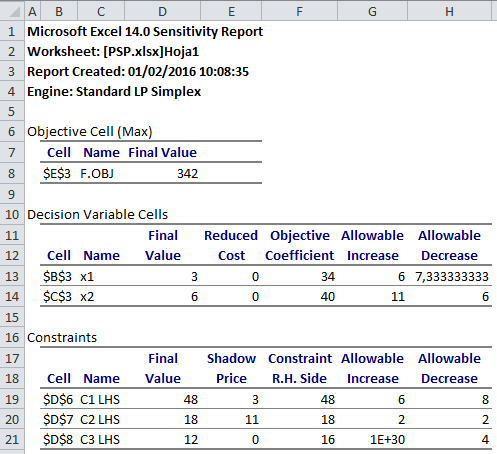
=(C4*D4+C5*D5)/C7
which can be interpreted as the sum of volume of the pure chemicals divided by the volume of the whole mixture.
Figure 3. Sample data for Sensitivity Report
Our goal is to obtain a mixture concentration of 10% by determining the required volume of the reagents, with the concentration of each reagent remaining constant. We have the following constraints:
- The volume of the whole mixture must still be equal to 110 liters
- The available stock for reagent B is only 5 liters
How to generate a sensitivity report?
We must first use the Excel Solver Analysis and after we have performed the calculation, we can then generate the sensitivity report. We follow these step-by-step procedure:
- Click Data tab > Solver button
The Solver Parameters dialog box will appear.
Figure 4. Solver Parameters dialog box
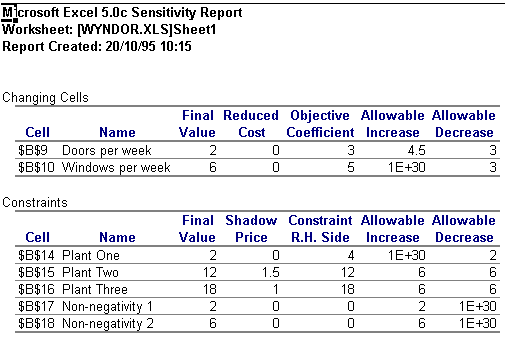
- Enter the following information needed by Solver as shown below:
- Set objective: D7
- To: Value of 10%
- By changing variable cells: C3:C5
- Subject to the constraints:C5<=5
C7 = 110
Figure 5. Entering the values
- Click Solve
- The Solver Results dialog box will appear. Tick Keep Solver Solution and under Reports, select Sensitivity. Click OK.
Figure 6. Sensitivity Report option in Solver Results
The time it takes for Solver to complete the calculations might vary depending on the complexity of the problem.
The optimal solution will then reflect in cells C3 to C5 in our worksheet (Sheet 1 below). The Sensitivity Report will be generated in another worksheet named Sensitivity Report 1.
Figure 7. Excel Solver optimization results
This is how a Sensitivity Report is presented:
Figure 8. Output: Sensitivity Report
How to interpret a sensitivity report?
The sensitivity report shows the names, corresponding cells and final values of the variable cells and constraints. The value of the Lagrange multiplier is a measure of the sensitivity of the constrained objective to changes in the constrained variables. Excel Solver offers other sensitivity reports and we can further explore this analysis tool to solve more complicated optimization problems and generate more detailed reports.
Instant Connection to an Excel Expert
Most of the time, the problem you will need to solve will be more complex than a simple application of a formula or function. If you want to save hours of research and frustration, try our liveExcelchat service! Our Excel Experts are available 24/7 to answer any Excel question you may have. We guarantee a connection within 30 seconds and a customized solution within 20 minutes.
J E Beasley
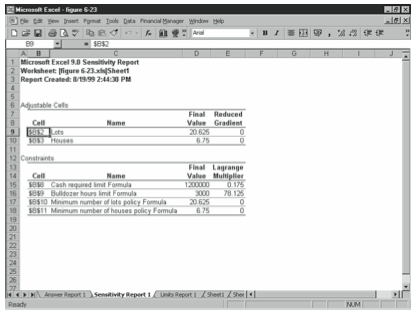
OR-Notes are a series of introductory notes on topics that fall under the broad heading of the field of operations research (OR). They were originally used by me in an introductory OR course I give at Imperial College. They are now available for use by any students and teachers interested in OR subject to the following conditions. Rusty lake hotel.
A full list of the topics available in OR-Notes can be found here.
Linear programming - sensitivity analysis - using Solver
Recall the production planning problem concerned with four variants of the same product which we formulated before as an LP. To remind you of it we repeat below the problem and our formulation of it.
Production planning problem
A company manufactures four variants of the same product and in the final part of the manufacturing process there are assembly, polishing and packing operations. For each variant the time required for these operations is shown below (in minutes) as is the profit per unit sold.
- Given the current state of the labour force the company estimate that, each year, they have 100000 minutes of assembly time, 50000 minutes of polishing time and 60000 minutes of packing time available. How many of each variant should the company make per year and what is the associated profit?
- Suppose now that the company is free to decide how much time to devote to each of the three operations (assembly, polishing and packing) within the total allowable time of 210000 (= 100000 + 50000 + 60000) minutes. How many of each variant should the company make per year and what is the associated profit?
Production planning solution
Variables
Let:
xi be the number of units of variant i (i=1,2,3,4) made per year
Excel Solver Not Showing Sensitivity Report
Tass be the number of minutes used in assembly per year
Tpol be the number of minutes used in polishing per year
Tpac be the number of minutes used in packing per year
Excel Solver Nt Generating Sensitivity Report
where xi >= 0 i=1,2,3,4 and Tass, Tpol, Tpac >= 0
Constraints
(a) operation time definition
Tass = 2x1 + 4x2 + 3x3 + 7x4 (assembly)
Tpol = 3x1 + 2x2 + 3x3 + 4x4 (polish)
Tpac = 2x1 + 3x2 + 2x3 + 5x4 (pack)
(b) operation time limits
The operation time limits depend upon the situation being considered. In the first situation, where the maximum time that can be spent on each operation is specified, we simply have:
Tass <= 100000 (assembly)
Tpol <= 50000 (polish)
Tpac <= 60000 (pack)
In the second situation, where the only limitation is on the total time spent on all operations, we simply have:
Tass + Tpol + Tpac <= 210000 (total time)
Objective
Presumably to maximise profit - hence we have
maximise 1.5x1 + 2.5x2 + 3.0x3 + 4.5x4
which gives us the complete formulation of the problem.
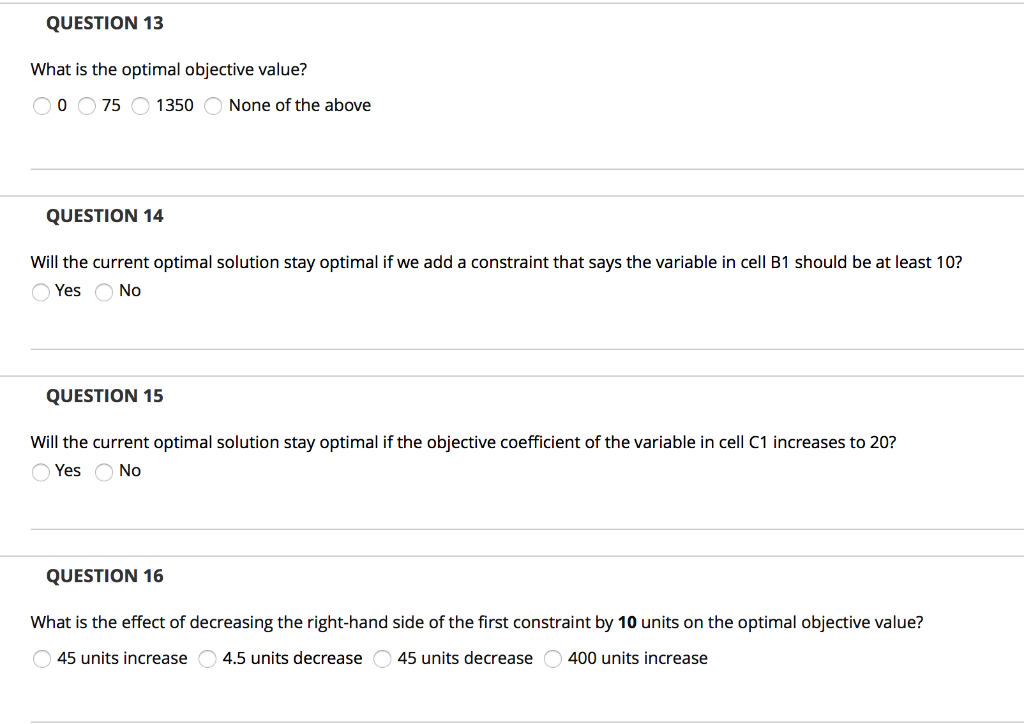
Solution - using Solver
Below we solve this LP with the Solver add-in that comes with Microsoft Excel.
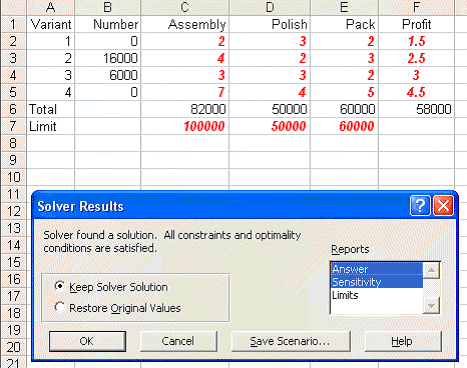
=(C4*D4+C5*D5)/C7
which can be interpreted as the sum of volume of the pure chemicals divided by the volume of the whole mixture.
Figure 3. Sample data for Sensitivity Report
Our goal is to obtain a mixture concentration of 10% by determining the required volume of the reagents, with the concentration of each reagent remaining constant. We have the following constraints:
- The volume of the whole mixture must still be equal to 110 liters
- The available stock for reagent B is only 5 liters
How to generate a sensitivity report?
We must first use the Excel Solver Analysis and after we have performed the calculation, we can then generate the sensitivity report. We follow these step-by-step procedure:
- Click Data tab > Solver button
The Solver Parameters dialog box will appear.
Figure 4. Solver Parameters dialog box
- Enter the following information needed by Solver as shown below:
- Set objective: D7
- To: Value of 10%
- By changing variable cells: C3:C5
- Subject to the constraints:C5<=5
C7 = 110
Figure 5. Entering the values
- Click Solve
- The Solver Results dialog box will appear. Tick Keep Solver Solution and under Reports, select Sensitivity. Click OK.
Figure 6. Sensitivity Report option in Solver Results
The time it takes for Solver to complete the calculations might vary depending on the complexity of the problem.
The optimal solution will then reflect in cells C3 to C5 in our worksheet (Sheet 1 below). The Sensitivity Report will be generated in another worksheet named Sensitivity Report 1.
Figure 7. Excel Solver optimization results
This is how a Sensitivity Report is presented:
Figure 8. Output: Sensitivity Report
How to interpret a sensitivity report?
The sensitivity report shows the names, corresponding cells and final values of the variable cells and constraints. The value of the Lagrange multiplier is a measure of the sensitivity of the constrained objective to changes in the constrained variables. Excel Solver offers other sensitivity reports and we can further explore this analysis tool to solve more complicated optimization problems and generate more detailed reports.
Instant Connection to an Excel Expert
Most of the time, the problem you will need to solve will be more complex than a simple application of a formula or function. If you want to save hours of research and frustration, try our liveExcelchat service! Our Excel Experts are available 24/7 to answer any Excel question you may have. We guarantee a connection within 30 seconds and a customized solution within 20 minutes.
J E Beasley
OR-Notes are a series of introductory notes on topics that fall under the broad heading of the field of operations research (OR). They were originally used by me in an introductory OR course I give at Imperial College. They are now available for use by any students and teachers interested in OR subject to the following conditions. Rusty lake hotel.
A full list of the topics available in OR-Notes can be found here.
Linear programming - sensitivity analysis - using Solver
Recall the production planning problem concerned with four variants of the same product which we formulated before as an LP. To remind you of it we repeat below the problem and our formulation of it.
Production planning problem
A company manufactures four variants of the same product and in the final part of the manufacturing process there are assembly, polishing and packing operations. For each variant the time required for these operations is shown below (in minutes) as is the profit per unit sold.
- Given the current state of the labour force the company estimate that, each year, they have 100000 minutes of assembly time, 50000 minutes of polishing time and 60000 minutes of packing time available. How many of each variant should the company make per year and what is the associated profit?
- Suppose now that the company is free to decide how much time to devote to each of the three operations (assembly, polishing and packing) within the total allowable time of 210000 (= 100000 + 50000 + 60000) minutes. How many of each variant should the company make per year and what is the associated profit?
Production planning solution
Variables
Let:
xi be the number of units of variant i (i=1,2,3,4) made per year
Excel Solver Not Showing Sensitivity Report
Tass be the number of minutes used in assembly per year
Tpol be the number of minutes used in polishing per year
Tpac be the number of minutes used in packing per year
Excel Solver Nt Generating Sensitivity Report
where xi >= 0 i=1,2,3,4 and Tass, Tpol, Tpac >= 0
Constraints
(a) operation time definition
Tass = 2x1 + 4x2 + 3x3 + 7x4 (assembly)
Tpol = 3x1 + 2x2 + 3x3 + 4x4 (polish)
Tpac = 2x1 + 3x2 + 2x3 + 5x4 (pack)
(b) operation time limits
The operation time limits depend upon the situation being considered. In the first situation, where the maximum time that can be spent on each operation is specified, we simply have:
Tass <= 100000 (assembly)
Tpol <= 50000 (polish)
Tpac <= 60000 (pack)
In the second situation, where the only limitation is on the total time spent on all operations, we simply have:
Tass + Tpol + Tpac <= 210000 (total time)
Objective
Presumably to maximise profit - hence we have
maximise 1.5x1 + 2.5x2 + 3.0x3 + 4.5x4
which gives us the complete formulation of the problem.
Solution - using Solver
Below we solve this LP with the Solver add-in that comes with Microsoft Excel.
If you click here you will be able to download an Excel spreadsheet called lp.xls that already has the LP we are considering set up.
Look at Sheet A in lp.xls and to use Solver do Tools and then Solver. In the version of Excel I am using (different versions of Excel have slightly different Solver formats) you will get the Solver model as below:
but where now we have highlighted (clicked on) two of the Reports available - Answer and Sensitivity. Click OK and you will find that two new sheets have been added to the spreadsheet - an Answer Report and a Sensitivity Report.
As these reports are indicative of the information that is commonly available when we solve a LP via a computer we shall deal with each of them in turn.
Answer Report
The answer report can be seen below:
This is the most self-explanatory report.
We can see that the optimal solution to the LP has value 58000 (£) and that Tass=82000, Tpol=50000, Tpac=60000, X1=0, X2=16000, X3=6000 and X4=0.
Note that we had three constraints for total assembly, total polishing and total packing time in our LP. The assembly time constraint is declared to be 'Not Binding' whilst the other two constraints are declared to be 'Binding'. Constraints with a 'Slack' value of zero are said to be tight or binding in that they are satisfied with equality at the LP optimal. Constraints which are not tight are called loose or not binding.
Sensitivity Report
The sensitivity report can be seen below:
This sensitivity report provides us with information relating to:
- changing the objective function coefficient for a variable
- forcing a variable which is currently zero to be non-zero
- changing the right-hand side of a constraint.
We deal with each of these in turn, and note here that the analysis presented below ONLY applies for a single change, if two or more things change then we effectively need to resolve the LP.
Changing the objective function coefficient for a variable
To illustrate this suppose we vary the coefficient of X2 in the objective function. How will the LP optimal solution change?
Currently X1=0, X2=16000, X3=6000 and X4=0. The current solution value for X2 of 16000 is in cell B3 and the current objective function coefficient for X2 is 2.5. The Allowable Increase/Decrease columns tell us that, provided the coefficient of X2 in the objective function lies between 2.5+2 = 4.5 and 2.5 - 0.142857143 = 2.3571 (to four decimal places), the values of the variables in the optimal LP solution will remain unchanged. Note though that the actual optimal solution value will change as the objective function coefficient of X2 is changing.
In terms of the original problem we are effectively saying that the decision to produce 16000 of variant 2 and 6000 of variant 3 remains optimal even if the profit per unit on variant 2 is not actually 2.5 (but lies in the range 2.3571 to 4.50). Similar conclusions can be drawn about X1, X3 and X4.
Forcing a variable which is currently zero to be non-zero
For the variables, the Reduced Cost column gives us, for each variable which is currently zero (X1 and X4), an estimate of how much the objective function will change if we make (force) that variable to be non-zero. Note here that the value in the Reduced Cost column for a variable is often called the 'opportunity cost' for the variable.
Excel Solver Nt Generating Sensitivity Report Analysis
Hence we have the table
where we ignore the sign of the reduced cost when constructing the above table. The objective function will always get worse (go down if we have a maximisation problem, go up if we have a minimisation problem) by at least this estimate. The larger A or B are the more inaccurate this estimate is of the exact change that would occur if we were to resolve the LP with the corresponding constraint for the new value of X1 or X4 added.
Note here than an alternative (and equally valid) interpretation of the reduced cost is the amount by which the objective function coefficient for a variable needs to change before that variable will become non-zero.
Hence for variable X1 the objective function needs to change by 1.5 (increase since we are maximising) before that variable becomes non-zero. In other words, referring back to our original situation, the profit per unit on variant 1 would need to increase by 1.5 before it would be profitable to produce any of variant 1. Similarly the profit per unit on variant 4 would need to increase by 0.2 before it would be profitable to produce any of variant 4.
Changing the right-hand side of a constraint
For each constraint the column headed Shadow Price tells us exactly how much the objective function will change if we change the right-hand side of the corresponding constraint within the limits given in the Allowable Increase/Decrease columns
Hence we can form the table
For example for the polish constraint, provided the right-hand side of that constraint remains between 50000 + 40000 =90000 and 50000 - 10000 = 40000 the objective function change will be exactly 0.80[change in right-hand side from 50000].
The direction of the change in the objective function (up or down) depends upon the direction of the change in the right-hand side of the constraint and the nature of the objective (maximise or minimise).
To decide whether the objective function will go up or down use:
- constraint more (less) restrictive after change in right-hand side implies objective function worse (better)
- if objective is maximise (minimise) then worse means down (up), better means up (down)
Hence
- if you had an extra 100 hours to which operation would you assign it?
- if you had to take 50 hours away from polishing or packing which one would you choose?
- what would the new objective function value be in these two cases?
The value in the column headed Shadow Price for a constraint is often called the 'marginal value' or 'dual value' for that constraint.
Note that, as would seem logical, if the constraint is loose the shadow price is zero (as if the constraint is loose a small change in the right-hand side cannot alter the optimal solution).
Comments
- Different LP packages have different formats for input/output but the same information as discussed above is still obtained.
- You may have found the above confusing. Essentially the interpretation of LP output is something that comes with practice.
- Much of the information obtainable (as discussed above) as a by-product of the solution of the LP problem can be useful to management in estimating the effect of changes (e.g. changes in costs, production capacities, etc) without going to the hassle/expense of resolving the LP.
- This sensitivity information gives us a measure of how robust the solution is i.e. how sensitive it is to changes in input data.
Note here that, as mentioned above, the analysis given above relating to:
- changing the objective function coefficient for a variable; and
- forcing a variable which is currently zero to be non-zero; and
- changing the right-hand side of a constraint
Excel Solver Nt Generating Sensitivity Reporting
is only valid for a single change. If two (or more) changes are made the situation becomes more complex and it becomes advisable to resolve the LP.
